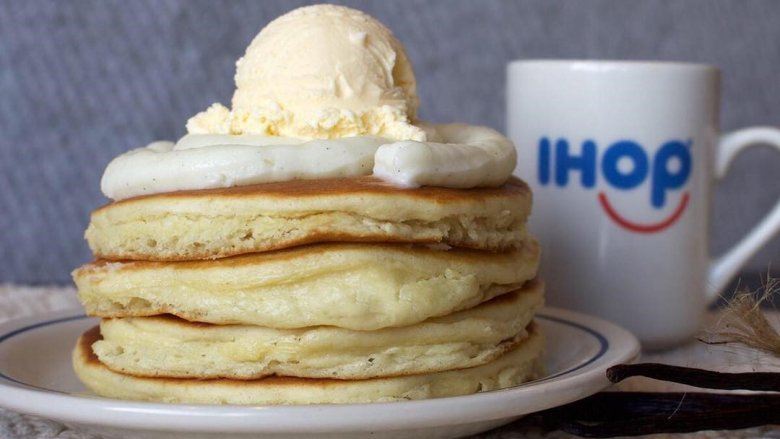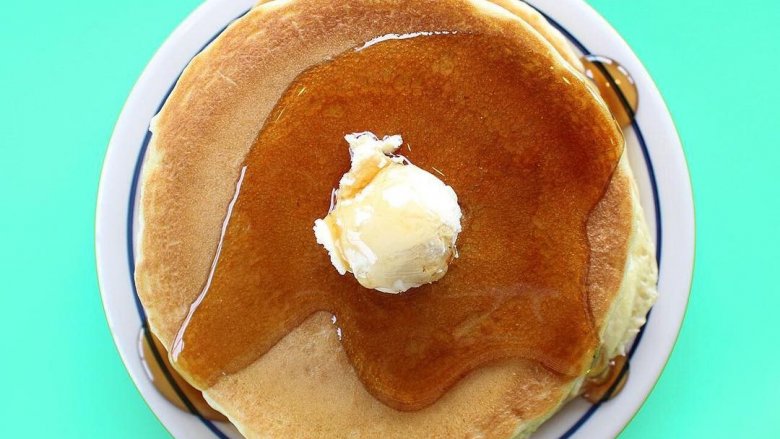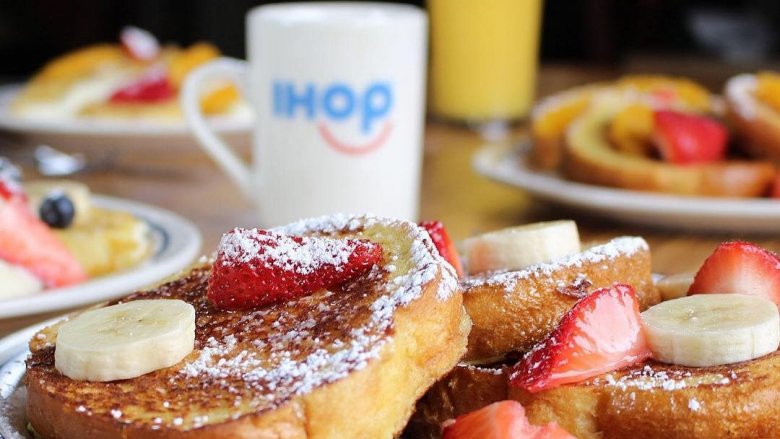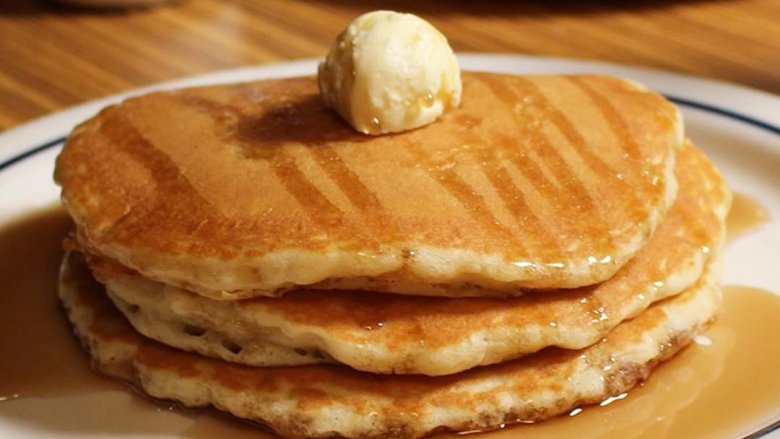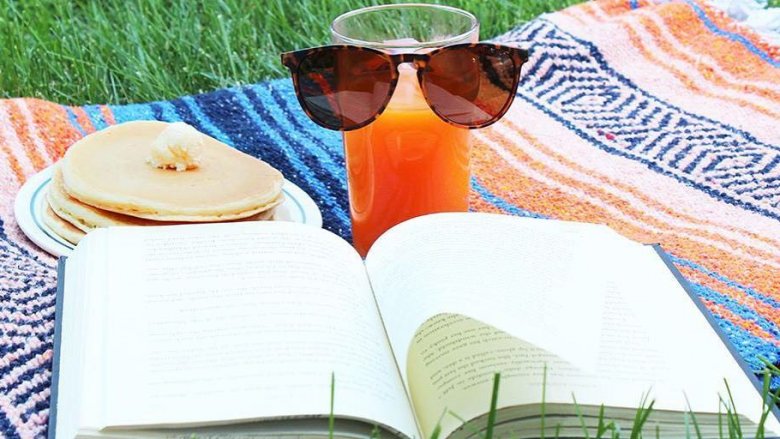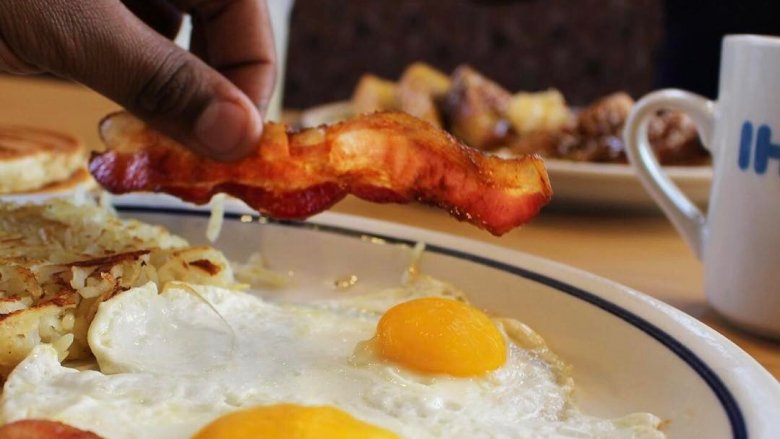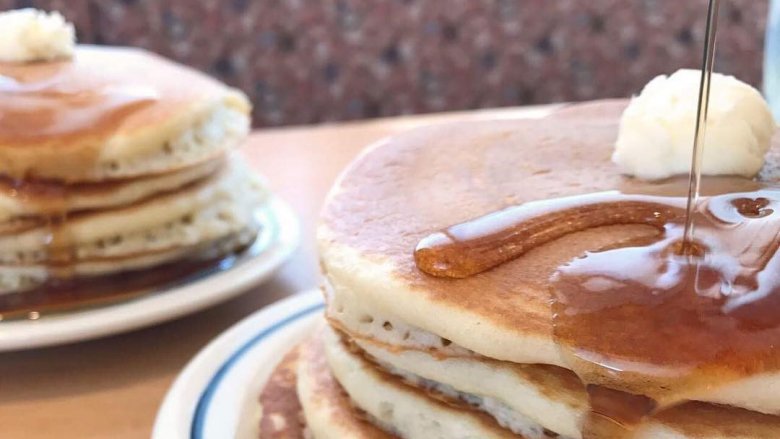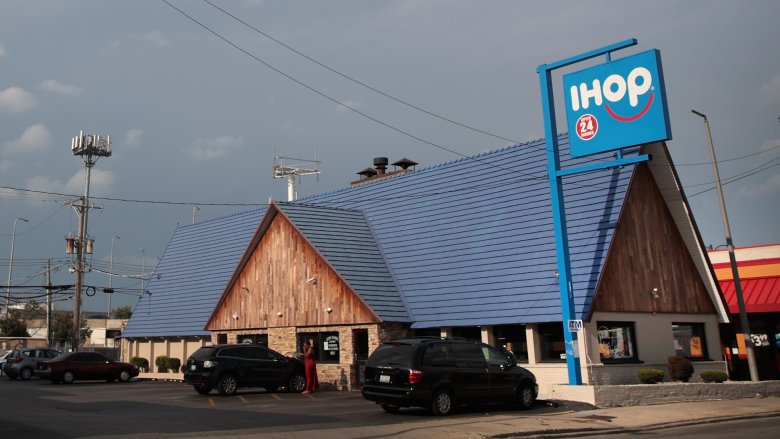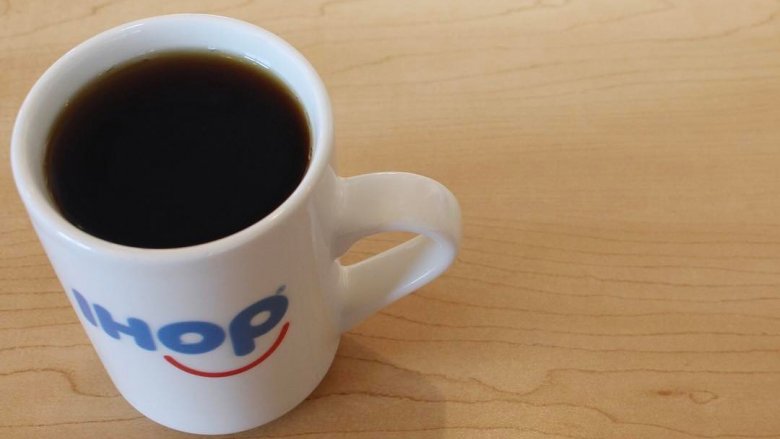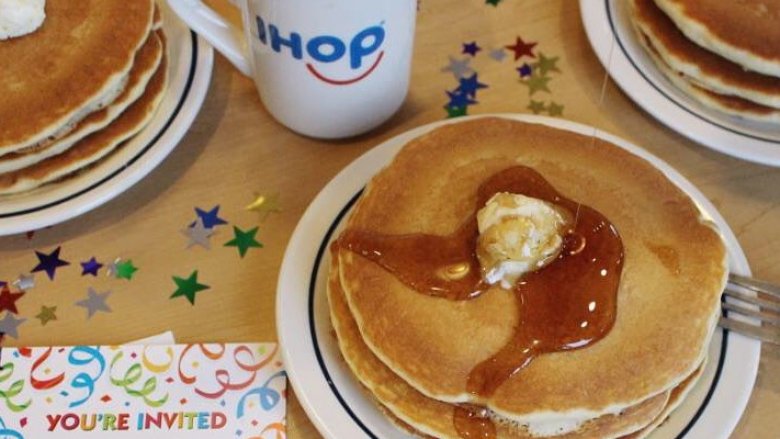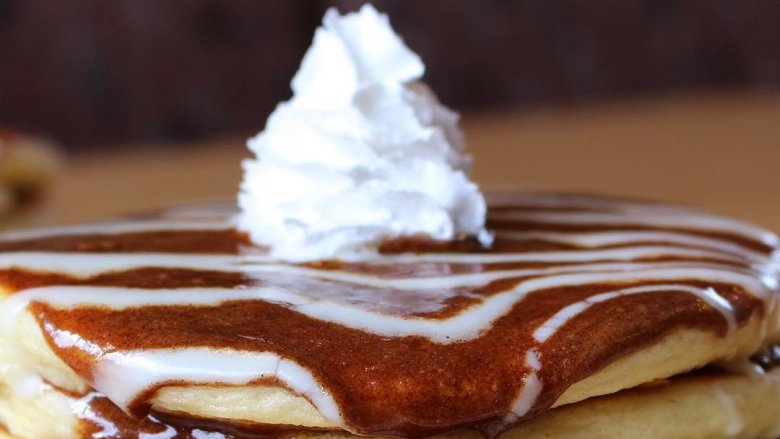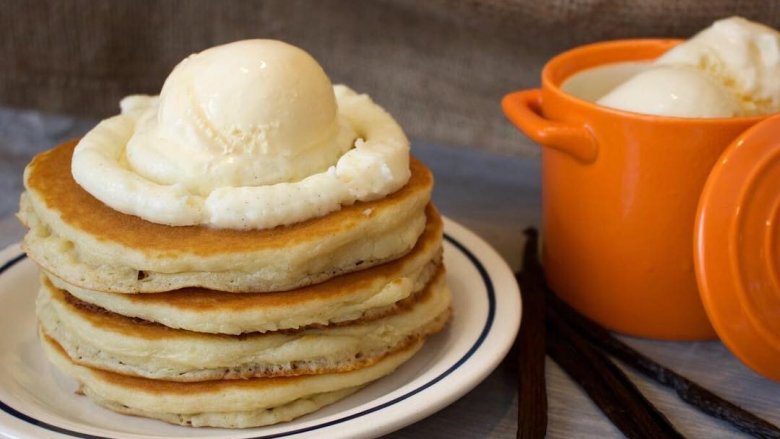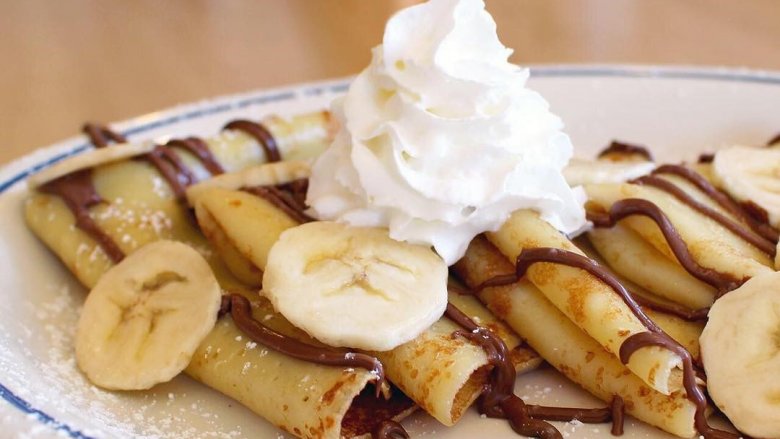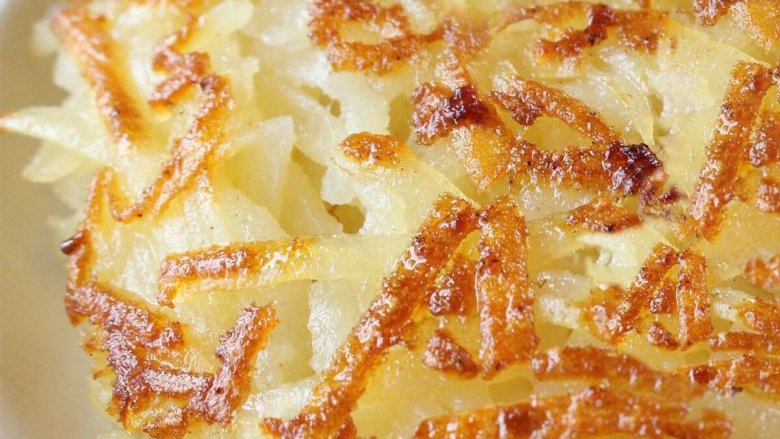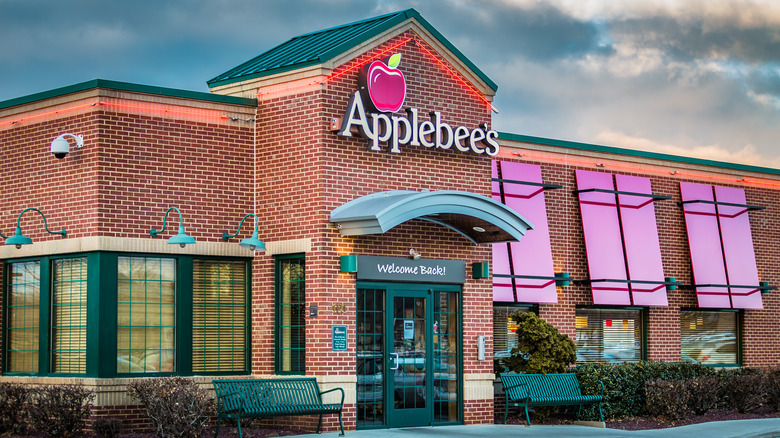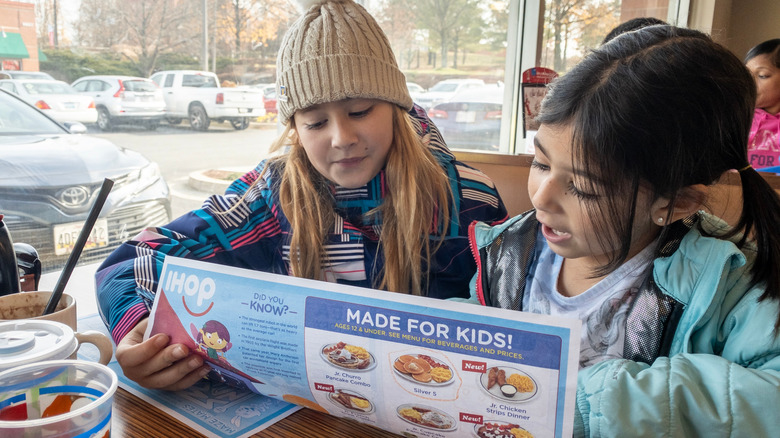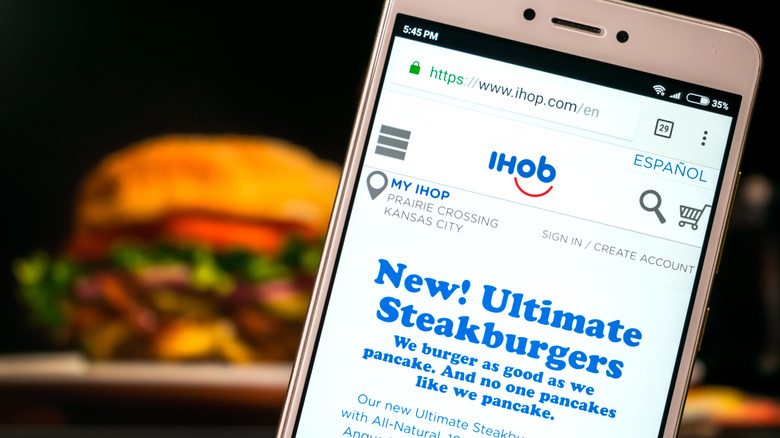IHOP: 17 Facts About The Pancake Palace
Sure, you can make pancakes at home pretty easily, but head out to breakfast (or lunch, or dinner) at IHOP, and it's easy to please the entire family. IHOP is so iconic that you can identify the shape of that building long before you even catch a glimpse of a sign, but there are still plenty of things you might not know about this American family favorite.
The oldest IHOP is across the street from the oldest Big Boy
Any IHOP connoisseur will appreciate a bit of ancient IHOP history, so let's talk about that very first location. According to the Toluca Lake Chamber of Commerce, they weren't just the home of Warner Brothers, Amelia Earhart, and, at one time, saber-toothed tigers, they were also the home of the first IHOP. It opened in 1958, and even though it's a joint called Mo's now, there's another bit of fascinating history standing at that particular corner. It's right across the street from the country's oldest Big Boy, which opened in 1949 — making that intersection home to a special bit of Americana.
They sued another IHOP
Everyone knows IHOP stands for the International House of Pancakes, but do a quick Google search and you'll find there's another organization using that acronym. That's the International House of Prayer, and the pancake place sued the prayer place in 2010.
No one would ever confuse what services you're going to be getting at either one. Instead, the problems began when the church started serving food. They also say that not only was "IHOP" trademarked by the restaurant in 1973, but they made repeated requests to the church to stop using the name — which were ignored. The lawsuit was dropped only a few months later and the matter was being mediated in hopes of settling out of court. As of 2017, the church is using IHOPKC to separate them from the restaurant.
They created National Pancake Day
It might seem like there's a special day for everything, but IHOP's National Pancake Day is something we can all get behind. They started making March 7 something special in 2006, and the idea isn't to recognize the humble pancake, it's to raise some serious money for charity. IHOP partnered with Children's Miracle Network Hospitals, Shriners Hospitals for Children, and the Leukemia & Lymphoma Society for the day, asking their guests to make a donation to any one of the charities instead of paying the standard purchase price for a short stack of pancakes.
They're not talking about small change, either. In 2017, the chain estimated that it would be serving 5 million pancakes and raising about $3.5 million for charity, which would be added onto its already impressive total of more than $24 million they've raised for some great causes.
The International originally referred to their menu, not their locations
It's a bit ironic that the International House of Pancakes became such an iconic piece of Americana, but it turns out that "international" didn't refer to any aspirations of becoming an internationally, globally-recognized chain. Instead, the name was actually a reference to the restaurant's menu.
The idea was to have pancakes from all over the world, and for a while, they did. Originally, the menu included things like the historically-named Persian pancake, the exotic-sounding Tahitian orange pineapple pancake, and even a Kauai coconut pancake. That one was covered in coconut and a coconut-sugar sauce they actually imported from the Philippines, and if that doesn't sound too cost-effective, it probably wasn't. A lot of those original recipes were created by a chef named Pete Marsoobian, and IHOP still uses the same basic recipes they've used for decades.
One Manhattan IHOP has had epic stink problems
Living next to an IHOP would be horrible for your waistline and for your heart, but one Manhattan neighborhood has found out the hard way there's another problem: the smell. In 2012, a feud began brewing between an East Village IHOP and its neighbors. People living in the area complained that the smell of bacon grease was so bad it was disrupting their sleep, and honestly, can you think of anything worse than the constant smell of bacon that's not going to be eaten by you?
IHOP tried to appease them by installing a $40,000 machine on top of the building. The so-called smog-hog was designed to remove all odors before they had a chance to escape, and it sounds like a good plan, right? The feud didn't go away, though, and it wasn't long before those same neighbors were now complaining because IHOP's smog-hog was all but deafening. Sometimes, there's just no winning.
Vermont IHOPs have a special menu item
Part of the allure of IHOP is all those syrups. They're sweet, they're delicious, and no one is ever going to try to pretend they're good for you (or natural), but that's part of what makes them so good. At least, outside of South Burlington, Vermont.
Vermont is known for its maple syrup, and the idea of eating pancakes in Vermont without slathering on some fresh, very real maple syrup is pretty unthinkable. That's why South Burlington made a special agreement with IHOP — they would be the only location out of around 1400 that would be allowed to offer real maple syrup with all those flavored, fruity favorites. Perhaps most shockingly, franchise owner Sam Handy, Jr., said that when IHOP representatives came to the location to train their new franchisees, many of them also tried actual maple syrup for the very first time.
That iconic design has a definite purpose
IHOP was founded by entrepreneur Al Lapin, Jr., who died in 2004. Lapin decided to open IHOP after being inspired by the success other fast food joints were having in the 1950s, and after he decided to go with pancakes and waffles, he developed the iconic look of his restaurants. That distinctive blue roof was actually chosen because of a similarity to the instantly recognizable orange roofs of the popular Howard Johnson's chain, and that chalet-style building has a purpose, too. Lapin wanted his restaurants to have the appearance of a place you could go that would be every bit as welcoming and cozy as your own home, another brilliant marketing strategy from the man who always said his favorite pancakes were "the ones that sell."
Seeds of the idea were planted by concern over nuclear attack
There are a ton of restaurants out there that are open to fulfill a lifelong dream, but Al Lapin, Jr.'s story is a little different. Lapin started out in the movie business, not the restaurant one. After serving in World War II, he headed to film school and then got a job making movies for the US government. The subject was a pretty dark one that was on everyone's minds during the 1950s, and that was how to survive a nuclear attack.
How did he get from nuclear war to pancakes? The films included information on what kind of emergency plans were in place to get basic necessities into the hands of those who needed them most, and that got Lapin thinking about how coffee fits into that plan. It's a necessity, surely, and that led him to develop a plan for delivering coffee to businessmen across LA. IHOP followed not long after when the coffee salesman got inspired by the success of McDonald's. Enter: pancakes... and a pot of coffee on every table.
One franchisee held a special Cinn-A-Stack party for a WV girl
It's always inspiring to see a business going above and beyond for its customers, and that's exactly what IHOP franchisee Tommy Tsitouris of Morgantown, West Virginia did for one of his 5-year-old customers. When Leah DeBarr's parents took her to IHOP after a particularly painful (and shot-filled) doctor's visit, they found her favorites were no longer on the menu. They couldn't get Cinn-A-Stack pancakes anymore, but when Tsitouris and IHOP got wind of the little girl's heartbreak, they not only held a Cinn-A-Stack-filled surprise party for her, but they put the pancakes back on the menu, albeit for a limited time. Still, that's some serious customer service!
You can still get Cinn-A-Stack pancakes
Hearts broke when IHOP took their Cinn-A-Stack pancakes off the menu, and it's no wonder — they're delicious, and there's no way we could possibly have too many ways to legitimately have dessert for breakfast. Fortunately, you're covered.
You can totally do some creative menu-hacking to get Cinn-A-Stack pancakes any time, because the same thing that makes them delicious is used on their Cinnamon Swirl French Toast. Just order some buttermilk pancakes, and ask them to use that cinnamon spread and some cream cheese frosting. Presto!
Their pancakes were used in a hilarious scientific study
There aren't too many restaurants that can say they've made a major contribution to the scientific community, but IHOP has — and it's hilarious. Anyone who's driven across the American Midwest knows why the saying developed that it's as flat as a pancake, but is it really? That's what Texas State and Arizona State University researchers wanted to know, and their study was published in the Annals of Improbable Research in 2003.
They took an IHOP pancake, did some adjusting for size, and compared it to the topography of Kansas. The results? Yes, Kansas is absolutely flatter than a pancake. That wasn't enough of a result, though. In 2014, University of Kansas researchers replied that there are actually six states that are flatter than an IHOP pancake: Florida, Illinois, North Dakota, Louisiana, Minnesota, and Delaware. They also determined that in order to be statistically less flat than a pancake, Kansas would need to have a mountain higher than Mount Everest. Who says science is boring?
Their menu contains a shocking amount of sodium
You can head to IHOP and make some decent choices when it comes to calorie counts... and you can also make some horrific ones. Three buttermilk pancakes will only set you back around 430 calories, according to their nutritional information, but that doubles if you go for something like the New York Cheesecake Pancakes or — surprisingly — the deceptively healthy-sounding Harvest Grain 'N Nut Pancakes.
But let's talk sodium. The American Heart Association says you should limit your sodium intake to no more than 1500 mg per day, and that makes it terrifying that that same New York Cheesecake Pancakes clock in at a heart-stopping 2040 mg. Other menu items are no better, and there are a ton of items that contain more than 2000 mg of sodium, including an order of five buttermilk pancakes, breakfast crepes, biscuit and gravy, the breakfast sampler, chicken fried chicken, and if you opt for the country fried steak and eggs with country gravy, you're looking at 3540 mg. That's insane!
You can eat vegan at IHOP
Going out to eat is always a bit of a challenge if you're vegan, and in many places, you're not so much checking the menu for what you want to eat, but for what you can eat. IHOP has you covered, though: there is plenty you can choose off the menu if you're vegan.
Go for things like butter-free hash browns, baked potato, fruit, and flavored coffee, but there are less obvious things, too. Their fries, oatmeal, and English muffins are vegan, and you can absolutely ask for an egg- and cheese-free omelet to get a plate piled high with roasted veggies. That's a win for those who aren't even vegan!
IHOP bought Applebee's in 2007
What do IHOP and Applebee's have in common? Bacon burgers! Actually yes, they do both serve bacon burgers but that's not the main thing the chains have in common. Both are owned by "Dine Brands," the company that also owns the unfortunately named Fuzzy's Taco Shop, which you've probably never heard of.
The beautiful marriage of IHOP and Applebee's happened in 2007 when IHOP paid $2.1 billion to acquire the other chain. Analysts at the time thought it was a risky move, what with soaring operating costs in the restaurant sector and consumers' petty concerns about high gas prices (oh consumers of the past, if only you knew what lay ahead). The purchase was part of IHOP's master plan to take over the chain restaurant universe — just kidding, but it was part of their plan to transform their business into a franchise system. Shortly after the acquisition, the parent company of both brands renamed itself "Dine Brands."
Today, Dine Brands has achieved its dream of 100% independently operated franchises, featuring "good food" or, in the case of Fuzzy's Taco Shop, "stellar food." No bacon burgers at Fuzzy's, though. It has always been the black sheep of the family.
A menu makeover boosted sales
If you had to describe IHOP to a friend — a friend who's been living in a cave on a rocky island off the coast of Newfoundland, perhaps — you'd probably say "they serve pancakes." Let's face it: "pancakes" really aren't a super unique selling point. You can get pancakes at any greasy spoon in America, or even out of a box of grocery store pancake mix.
Prior to 2014, when you opened up an IHOP menu, what you saw was pancakes, pancakes, and more pancakes — and how exactly does one choose between pancakes and pancakes? IHOP tackled this problem not by adding non-pancake menu items, but by redesigning the menu and how it presented all those pancakes to customers. In the new design, each pancake option had its own photo and description. Instead of reading through the "War and Peace" of breakfast combo options, you could just add a "side" of whatever you wanted. IHOPs most popular combos got glamor shots at the bottom of the page. The menu featured fewer items, too, so customers wouldn't be overwhelmed with choices.
So how did that work out? Well, for a surprisingly simple change, it was shockingly effective. The move fueled a 4% increase in sales. That doesn't sound like a lot but, when you make $18 million a year, it's a pretty significant amount of pocket change.
One of IHOP's co-founders designed movie posters
Legend says Slenderman loves pancakes, but that's probably the only link between IHOP and horror movies you've ever pondered. So, it may surprise you to learn that IHOP and the horror genre actually have a much deeper link that goes all the way back to its earliest years.
One of IHOP's early investors was a man named Albert Kallis. He was an artist — specifically, a movie poster artist. Before there was IHOP, there was "The Beast with 1,000,000 Eyes," "The Day the World Ended," and "The Phantom from 10,000 Leagues." If these sound like B-movies, it's because they are. Kallis was recruited by B-movie director Roger Corman in the mid-1950s to design posters for dozens of awful horror movies featuring werewolves, sea serpents, giant, veiny-headed aliens, and scantily-clad women.
Kallis designed movie posters for 17 years. Because these weren't exactly "Star Wars" or "Blade Runner"-caliber films, there's a good chance you've never heard of most of them, unless you're a particular fan of sci-fi schlock or "Mystery Science Theater 3000."
Its IHOB campaign confused customers
Back in 2018, IHOP announced that it was planning to change its name to IHOB, but didn't say why. All across America, people were like, "Huh?" IHOP let this go on for a week before finally announcing that the "B" stands for "burgers," and it wouldn't actually be changing its name. It turns out that the weird IHOB tease was really meant to remind people that it sells burgers and is open for lunch and dinner.
So how'd that work out? Well, perhaps no other campaign in the history of marketing has inspired such collective confusion. Some analysts crowed that the attempt was a failure since it left IHOP open to ridicule from random people, celebrities, and real burger joints like Wendy's and Burger King (the latter created a temporary "Pancake King" logo to Tweet-scoff IHOP's name change).
But really, IHOP had the last laugh. The following year, the company's chief marketing officer announced that the name change had fueled a whopping 400% increase in burger sales — so, "Pancake King," how many pancakes did you sell? In fact, at one point the company was selling half a million burgers a week, which doesn't exactly sound like failure. Since this followed 10 straight quarters of declining sales, it seems as if IHOP's odd campaign did exactly what it was supposed to do.
